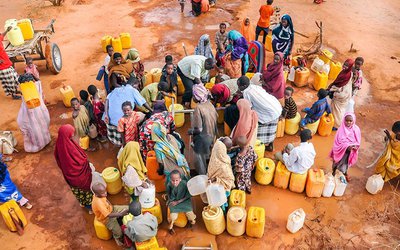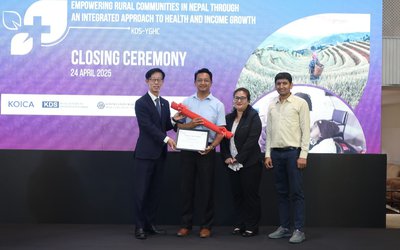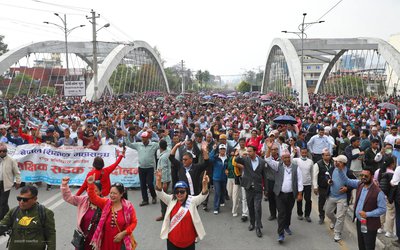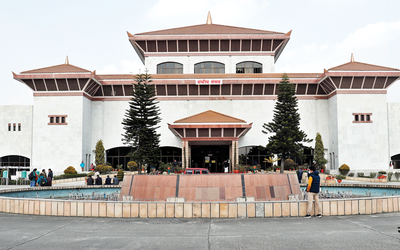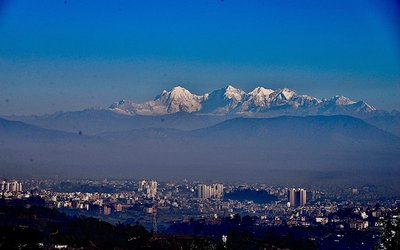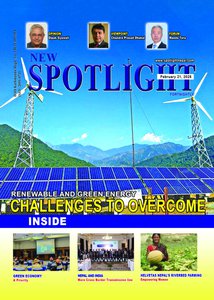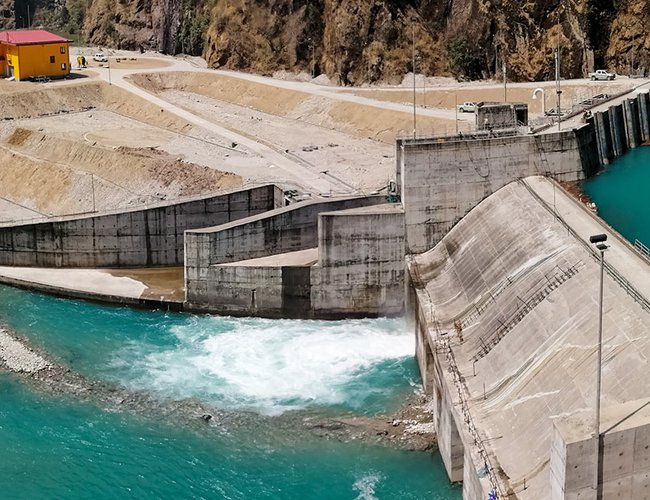
Several countries are experiencing water shortage to meet their requirements for drinking, irrigation, energy generation, industrial production and for water-dependent other sectors such as waste management, tourism and urban development. Water is a critical resource to meet existing demands, and is a major 'risk' to accelerate water-induced disasters. Although Nepal has plenty of water in river systems, lakes, reservoirs, and wetlands, number of urban areas and settlements face difficulties in meeting drinking water demands, and agriculture production still depends on monsoon. Nepal experiences 'too much water' during the rainy season, and 'too little water and drought' during the dry months.
In recent years, water resource is adversely affected from temperature rise uneven precipitation. In addition to other climate-induced disasters, hills and mountains experience landslides, and terai is severely impacted by floods and sedimentation. Nepal is highly climate vulnerable, and is in high climate risk. Key climate impacts are related to reduced water availability, altered spatial-temporal distribution, and change in hydrological cycle. Water availability has increased from snow melting for short period, indicating long-term impacts on hydro-electricity generation, irrigation, drinking water supply and recreational facilities. Climate change has accelerated snow melting, increased formation of new glacial lakes, and expanded existing glacier lakes, posing additional threats of GLOFs.
It is reported that electricity generation has declined by 6.9% in 2020/21 as compared to 2019/20 due to reduction in rainfall, water holding capacity and effect on river discharge. Furthermore, river flows in dry season will be insufficient to operate run-of-the-river hydroelectricity projects, irrigate crop lands and provide recreational facilities. Decrease in energy supply will have multifold impacts on social and economic sectors. Based on 2014 study, economic cost of climate change on hydroelectricity generation will reach up to 0.3% of GDP/year in extremely dry seasons. In recent years, climate-induced disasters have claimed lives and property. This evidence urges making 'water-smart' climate policy and 'climate-smart' water policy so as to reduce climate change impacts and ensure sustained use of water resources.
Over a decade of experience in implementing adaptation projects as prioritised in the National Adaptation Program of Action, water has a pivotal role in mitigating several climate impacts, as water contributes to reduce carbon emissions, generate renewable energy, and sequestrate carbon. However, 'water-centred' adaptation programs are yet to implement in Nepal, document and share experiences and learning.
Under the leadership of Water and Energy Commission Secretariat and support from Global Water Partnership hosted by Jalsrot Vikas Sanstha (JVS) in Nepal,Global Water Leadership program is initiated to strengthen collaboration in water resources and WASH governance, utilize evidence and norms to inform climate-resilient water policies, and develop actions- and cost-based response strategy to address prioritised barriers. Under this program, multi-stakeholder consultation process has prioritised three key barriers namely policy implementation, institutional coordination, and data & capacity building. Three working groups are engaged in developing barriers-based strategies.
To better understand linkages between water resources and climate change, Alliance for Global Water Adaptation, and Adaptation Action Coalition with other partners and support from UKaid initiated Water Tracker tool to self-assess and enhance water resilience in national climate planning. Application of this tool in 14 climate change and water resources policies and plans in Nepal informs, inter alia, that: (a) water is considered as risk in many policies & plans and a sector & resource in a few policies; (ii) adaptation actions are prioritized for implementation in reviewed policies and plans; (iii) water requirements for mitigation targets & adaptation goals and water requirements & allocations for water-dependent sectors are not recognized; (iv) policies and plans mention the need for bilateral & multilateral supports for their implementation but do not consider accessing climate finance. Furthermore, climate change policies do not realize the critical role of water in meeting water requirements of social and economic sectors; and water sector plans do not consider additional avenues for accessing climate finance.
Nepal has formulated number of policies and plans both in climate and water resources sector and has estimated billions of US Dollars for their implementation. To name of few, Climate Change Policy (2019), Nationally Determined Contribution (NDC, 2020), National Adaptation Plan (NAP, 2021-2050), long-term Strategy for Net Zero Emission (2021), Water Resources Policy (2020) and Irrigation Master Plan (2019) etc. provide multiple opportunities to implement adaptation and mitigation options and make the social and economic sectors climate resilient. However, they require multi-billion US Dollars for implementation. The NDC Implementation Plan alone has estimated over US$ 36 billion, while NAP estimates over US$ 26 billion. Similarly, implementation of long-term Strategy for Net Zero Emission estimates over US$ 133 billion to implement existing measures and US$ 196 billion for additional measures for 2021-2050 period. This estimation urges exploring and access all funding opportunities to meet our national and international commitments.
Let us assume that Nepal received substantial financial resources to implement adaptation and mitigation actions, question arises on our country capacity and willingness to design appropriate plans and programs to reduce climate vulnerability and build adaptive capacity, reduce GHGs emissions, and commitment to effectively implement actions or facilitate implementation. Current practices of channelling activities and resources without provisions for necessary capacity building has also derailed to achieve the desired outcomes. Self-interpretation prevails, as activities are normally not designed for enhancing common understanding. In addition, availability of appropriate technologies and skills to use them are crucial for the success of designed activities. To improve performance, necessary training would be required before the project implementation. Although government works on process, it may wish to build capacity, utilize trained manpower, develop willingness, clarify responsibilities and provide incentives, ensure application of appropriate technologies, and provide adequate funding along with capacity enhancing, and monitoring & evaluation provisions. As Nepal's GHGs emission is below 0.06 % of the global emission, enhancing climate adaptation and resilience would contribute to reduce climate vulnerabilities and risks.

Batu Uprety
Former Joint-Secretary and Chief of Climate Change Management Division, Ministry of Environment (then), and former Team Leader, National Adaptation Plan (NAP) formulation process. E-mail: upretybk@gmail.com
- Teaming up Climate Change Negotiation
- Apr 18, 2025
- Sagarmatha Sambad: Likely Bearing the Fruits
- Mar 27, 2025
- Decadal Experience In Preparing The NDC
- Mar 03, 2025
- Over Five Decades Of Concern On Air Pollution
- Jan 16, 2025
- Damaging The Functional EIA Track
- Dec 22, 2024
